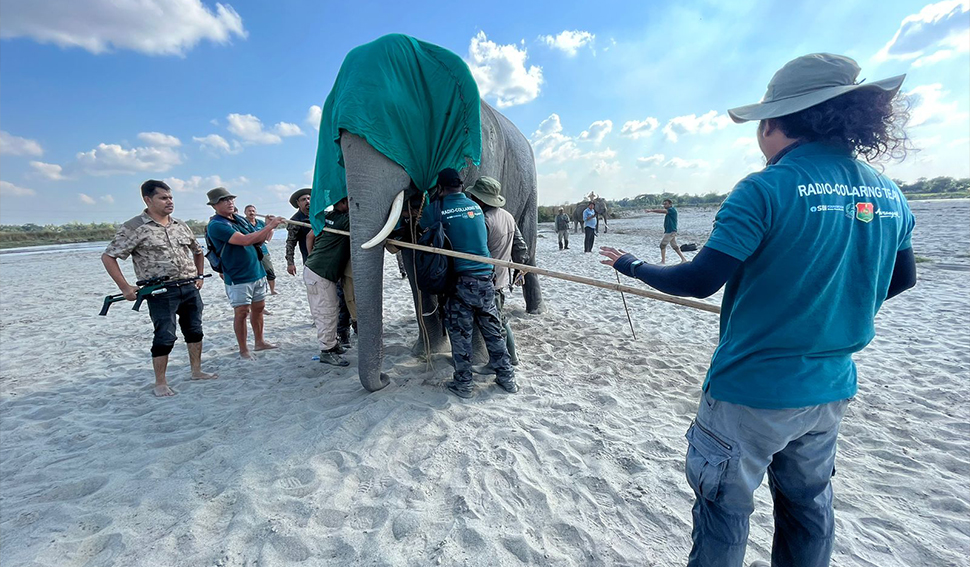1st wild elephant radio-collared in Assam to mitigate conflict with humans

In a significant step towards human-elephant coexistence and wildlife conservation, a tusker from a herd of approximately 50 elephants was radio-collared in Assam’s Baksa district on November 18. This initiative, led by the Assam Forest Department and Baksa Forest Division under the Bodoland Territorial Region (BTR), aims to mitigate human-elephant conflicts and monitor elephant movement effectively.
The operation, conducted at the Jartaluk area, was carried out by expert veterinarians, forest officials, and biologists under the leadership of Dr. C. Ramesh, Field Director of Manas Tiger Reserve, and the supervision of Golap Baniya, Divisional Forest Officer (DFO) of Baksa Forest Division.
After being tranquillized and fitted with the radio collar, the elephant rejoined its herd, ensuring minimal disruption to its natural behaviour.
This initiative was supported by the SBI Foundation and Prof. Curtis Griffin of the University of Massachusetts, USA.
Aaranyak, a leading biodiversity conservation organization in the Northeast, facilitated the operation.
The data from the radio-collared elephant will help in tracking the herd’s movement, enabling authorities to take proactive measures to reduce conflicts and safeguard both human and wildlife population.
The operation was supported by the Assam State Zoo, Aaranyak, and other stakeholders.
Ashwini Kumar, DFO of Assam State Zoo, highlighted the zoo’s role in the operation, stating, “We provided necessary veterinary support, medicines, tranquillizing guns, and related items to ensure the radio-collaring was successful. This initiative will help track elephant movements, enabling better conflict management.”
Sanjay Prakash, Managing Director of SBI Foundation, praised the effort, saying, “This milestone demonstrates the power of multi-stakeholder collaboration for wildlife conservation. We extend our gratitude to the Assam Forest Department, Aaranyak, and all involved for their dedication to conservation and human-elephant conflict mitigation.”
Kaushik Barua, a key member of the operation, emphasized the purpose of radio-collaring: “It helps determine elephant occupancy within a range, aiding in conflict management and conservation strategies.”
DFO Baksa, Golap Baniya, elaborated on the technical benefits: “The GPS-based satellite-radio telemetry collar tracks migratory patterns, and habitat preferences, and provides early alerts for conflict management. This is crucial for understanding elephant behaviour and implementing proactive measures.”
The operation also included contributions from wildlife biologists, researchers, WWF India, and local stakeholders, demonstrating a united approach to preserving Assam’s rich biodiversity and ensuring coexistence between humans and wildlife.
Dr. Bibhuti Prasad Lahkar, senior conservation scientist at Aaranyak and head of its Elephant Research and Conservation Division (ERCD), highlighted the initiative’s significance, stating, “Radio-collaring helps us understand the ecology, habitat utilization patterns, movement, and occupancy of elephants scientifically. This knowledge is essential for formulating effective conservation strategies.”
Dr. Lahkar credited Aaranyak’s dedicated biologists—Hiten Kumar Baishya, Abhijit Boruah, Anushka Saikia, and Dibakar Nayak—who monitored the elephant over the past two months to ensure the operation’s success.
The veterinary team for the operation included Dr. Bhaskar Choudhury of Wildlife Trust of India (WTI), Dr. Prabhat Basumatary, Forest Veterinary Officer at Manas Tiger Reserve, and Dr. Debabrat Phukan, Forest Veterinary Officer from Assam State Zoo. They were supported by a technical team from the Assam State Zoo.

Leave a Reply